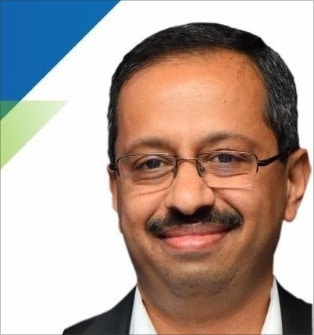VMware India CTO BS Nagarajan explains why application portability is a major challenge while moving to a hybrid cloud, and how VMware's latest cloud offering on AWS platform aims to address this and other issues

“Applications are the most critical part of most businesses today”, said VMware’s India CTO, BS Nagarajan, at an exclusive session he took for CyberMedia group’s analysts and journalists on hybrid cloud. Surely, applications have become extremely popular going by the numbers we witness on mobile app stores. They’re constantly re-defining user experience while raising expectations among users for a similar kind of experience in office. Organizations are trying hard to match that, and technology is also evolving to do the same. Hybrid cloud and edge computing are two examples of this evolution. Companies are spreading their applications across multiple cloud environments and innovating to leverage the edge. A key hurdle here is to smoothly migrate applications across different clouds while ensuring a smooth and consistent experience for users. Nagarajan, better known as BSN, explains some of these challenges and how VMware has evolved its cloud strategy to combat them. A key part of this strategy is to offer SDDC (Software-Defined Data Center) as a service on AWS’s platform. The service is already available in some other countries, and India is next. Here’s what it’s all about.
USERS EXPECT SIMILAR EXPERIENCE FROM ENTERPRISE APPLICATIONS AS THEIR PERSONAL ONES
There are millions of mobile apps on app stores. These are being continuously redeveloped to meet new user demands. They continue to woo users by the experience they offer, with thanks to their ever-evolving, self-service nature, and ease of use. It’s only natural therefore for users to expect and demand a similar experience from their enterprise apps when they go to office. According to BSN, that experience unfortunately is not as great because of old technology, bureaucratic processes, etc. Even a simple application request has to go through a long process of form submissions, approvals, and waiting time. BSN feels that this trend is now changing, where organizations are going through a huge change on how business applications work, all thanks to user demand for the same kind of experience. One of them is to make applications available on private and public clouds.
APPLICATION PORTABILITY ACROSS MULTI-CLOUDS A KEY ISSUE
As a result of increasing popularity of public and private clouds, organizations are spreading their applications across. It can’t be one or the other because both types of clouds have their own distinct advantages. Private clouds are preferred because they’re built internally, thereby giving complete control to customers. They can be secured as per govt.’s governance regulations, and applications can be tuned to the hardware because customers have become very familiar with them over the years. Private clouds however require a lot of time and efforts to build, run, and maintain.
Public clouds on the other hand, are always available and offer a lot of agility, elasticity, and scale. “You could get the infra you need in just 30 minutes, which would not be possible in a private cloud”, said BSN. However, public clouds aren’t always cheaper and you’re better off using private clouds instead.
Organizations need both public and private clouds today and in the future. The problem however is its complex and moving applications between different cloud environments can take months…since enterprises typically have hundreds of applications.
BSN explained this with a parallel example of buying your own car vs. renting an Ola or Uber. If you need to drive say 150 kms a day, then it’ll be cheaper to buy your own car (private cloud). Taking an Ola or Uber (public cloud) every day in this case would prove to be very expensive. However, if you have a wedding in the family, and you need to ferry guests to and from your home, then buying a car just for this would not make sense, and you’ll be better off using an Ola or Uber.
The point here is that organizations need both public and private clouds today and in the future. The problem however is the complexity involved in moving applications between different cloud environments. It can take months to re-code a single application to move it to a public cloud, and since enterprises typically have hundreds of applications, it can be a mammoth task.
VMWARE’S CLOUD STRATEGY ADDRESSES APPLICATION PORTABILITY
VMware’s cloud strategy has the answer to this and other challenges of managing enterprise applications in a hybrid environment. They intend to replicate the success they enjoyed from server virtualization where they provided a virtualization platform to customers that was agnostic of the underlying hardware. “So it doesn’t matter which vendor’s server you choose, our platform runs on all of them”, said BSN. Similarly, VMware’s cloud strategy is to allow customers to choose any cloud provider, and VMware would provide a common platform to manage all the applications.
This makes it easy for customers to move their applications across multiple clouds, which has been a key challenge while moving to the public cloud. “The process is very complex, and almost impossible if not completely impossible”, said BSN. “We want to adopt a strategy where it’s not a one-way journey. Customers should be able to move to a public cloud and back to their private cloud whenever they need to”, he added.
“We want to adopt a strategy where it’s not a one-way journey. Customers should be able to move to a public cloud and back to their private cloud whenever they need to”
–BS Nagarajan, CTO, VMware India
VMWARE OFFERS SDDC AS A SERVICE ON AWS CLOUD
With this strategy in mind, VMware partnered with AWS in 2016 to offer VMware’s cloud services on AWS’s platform. “As VMware is strong in private cloud space and AWS is a dominant public cloud player, there were no conflicts or overlap, making it a perfect partnership”, said BSN. The idea is to provide private cloud like functionality on a public cloud, all as a service. The good thing here according to VMware is that a lot of customers already have VMware skillsets and therefore don’t have to learn something different when they go to cloud. Even if they go on AWS, they would find the same technology that they’ve been using on-premise in their private cloud.
Application portability is the most powerful benefit of this, which is otherwise very complex and time-consuming because applications have been designed to work in a private cloud. “Companies can take many months to re-factor even one or two applications”, said BSN. With enterprises having hundreds of applications, it’s a mammoth task to move them. With VMware on AWS, companies can do this easily. The other advantage is that all support related to the service is offered by VMware and not AWS, even if it’s a hardware problem.
VMware offers four of its SDDC components on AWS—vSAN, NSX, vCenter, and vSphere. Here, vCenter is the mgmt. sw to manage all the other components. As VMware’s existing would already be running such a VMware environment on-prem, then it could be linked to a similar infrastructure on AWS and managed as a single, hybrid cloud.
A lot of companies already have VMware skillsets and therefore don’t have to learn something different when they go to public cloud. Even if they go on AWS, they would find the same technology that they’ve been using on-premise in their private cloud.
Infrastructure lifecycle management therefore becomes easy on VMware cloud, because companies don’t need to deploy, configure and patch systems, upgrade software versions, etc.
USE CASES OF VMWARE CLOUD ON AWS
There are multiple scenarios where companies could stand to benefit from using VMware on AWS. Data Center Evacuation, Consolidation, Hardware Refresh, Extension, or on Cloud are the key ones.
VMware already has lots of global customers already using it. One of them in Europe moved 450 applications to VMware’s cloud in just 5 days, which would otherwise have taken at least 5 months. Similarly, a bus/coach company in London moved around 600-650 applications in just 4 to 4.5 days.
BSN also gave the example of a customer who had to setup a DR site, and the hardware on their primary site was also due for a refresh. Besides heavy investments, the process of setup would have been extremely time consuming. It would have involved purchasing new hardware, migrating all applications to it, moving the old hardware to the DR site, and then start the data replication. The entire process would have easily taken them 8-10 months. VMware instead suggested them to migrate all their applications to VMware cloud on AWS, and use the old hardware on-prem for DR. In any case, most companies today run DR as in active-active mode, so latency sensitive applications could continue to run from on-prem, while others could run from the cloud.
COMPETITION FROM INTERMEDIARY HYBRID-CLOUD SOLUTIONS
There are intermediary options that give you public cloud like functionality on-prem? Then why have private cloud like functionality on a public cloud? There are a number of intermediary solutions out there like consumption-based models or composable infrastructure where companies can choose the amount of hardware resources they need for a particular application. According to BSN, that’s not equivalent of a public cloud. He feels it’s similar to paying the amount in installments than upfront. According to BSN, while such solutions can arrest some business going to public cloud, but it’s not equivalent to what a public cloud offers.
AVAILABILITY OF VMWARE CLOUD ON AWS
The company allows two ways to purchase VMware Cloud on AWS. One is pay-per-use, wherein you can choose to buy it cloud on demand as needed. The other is a loyalty program, wherein VMware offers discounts for existing customers who already have on-prem licenses of VMware.
As of writing this article, the company had setup VMware cloud across 6 of AWS’s 13 data center locations around the world. They intend to cover all locations by 2020.













